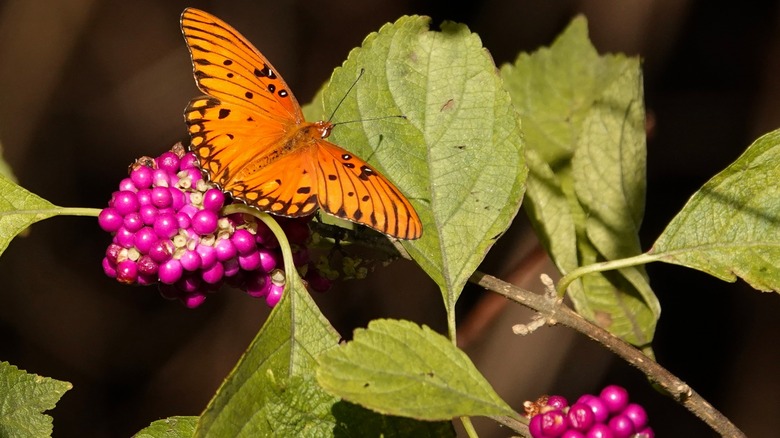The Native Shrub That Provides Color-Changing Berries From Summer Into Fall
Native plants and shrubs provide incredible benefits for pollinators, birds, and other wildlife, but growing native plants isn't only about the practical benefits. Some of the most gorgeous plants available are actually native to North America. This includes the appropriately named American beautyberry (Callicarpa americana). As its name suggests, this shrub has beautiful clusters of small berries that change from green to metallic purple as summer shifts to autumn.
Hardy in USDA zones 6 through 10, the American beautyberry is a member of the mint (Lamiaceae) family native to the Southeastern and Central U.S., as well as parts of the Caribbean. Their small pale-colored flowers are popular with bees and other pollinators, and while people don't generally consider their berries very flavorful, they're a hit with native birds, including robins, finches, and Eastern towhees. Cardinals will also flock to your yard to enjoy the berries, as will small mammals like armadillos, foxes, and opossums. One of the best things about beautyberries is that while many animals like them, mosquitoes do not, and beautyberries can even help keep mosquitoes out of your yard thanks to several compounds in their leaves.
Caring for beautyberries
Beautyberries are surprisingly easy shrubs to care for, and they grow well in most soil pHs and textures, including clay-heavy and sandy soils. They can handle full sun to partial shade, though in hot, dry regions, they may require additional water in full sun locations. They are generally quite drought tolerant once established and could be an ideal addition to waterwise gardens. They are not salt tolerant though, so be sure to protect them from deadly winter salt damage.
Widely available at garden centers as young plants, beautyberries can grow up to 9 feet tall in the right location but can easily be kept pruned to a more manageable size. You can remove older canes, as the plant fruits on new branches. Beautyberries have begun to attract the attention and appreciation they deserve, in part due to their changing berry colors. All species start with lavender-pink blossoms with lime-green berries between June and August. Those green berries turn magenta, violet, or white, depending on the species, and last until late fall.
Using beautyberries in the garden
Thanks to their tolerance for a variety of light and soil conditions, beautyberries are quite versatile in gardens. They can make excellent understory plants around native trees like dogwoods as long as they are kept pruned to a manageable size, and can also be grown as specimen shrubs if they are allowed to grow taller. Beautyberries also make excellent additions to pollinator and wildlife gardens and can even handle the moist soil of a rain garden. Plus, their gorgeous berries aren't just visible throughout summer and fall but can also serve as important food sources for birds and other critters during that time.
Because beautyberries can thrive in dry and rocky soil, they make good companions for other drought-tolerant natives like coneflowers and bee balm. As beautyberries can grow quite tall, they work best towards the back of gardens with these smaller plants, whose maximum height doesn't exceed 4 feet, located in front of them. Very petite flowers like butterfly milkweeds, which seldom grow past 2 feet tall, can then be planted in the very front, creating a colorful and drought-tolerant native garden.


